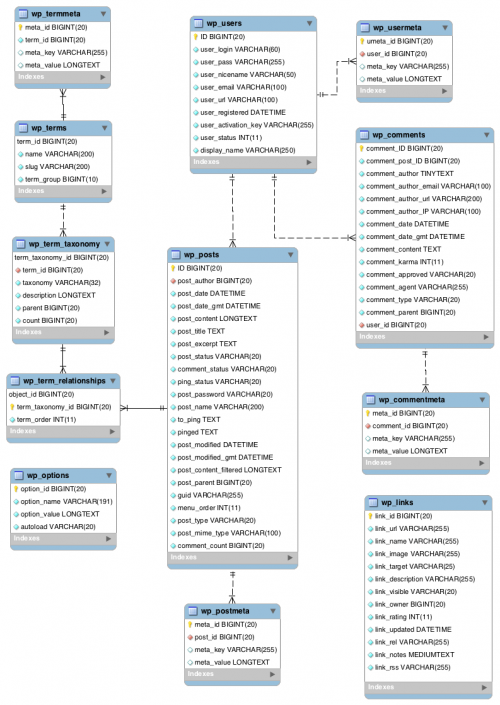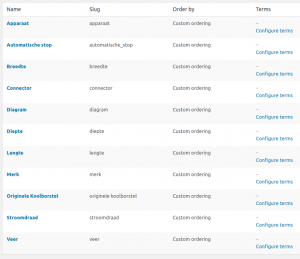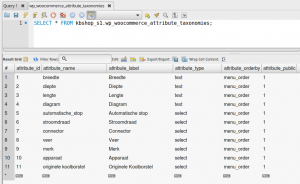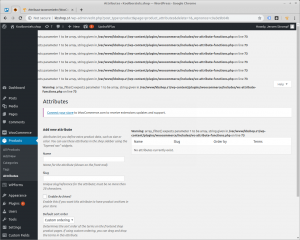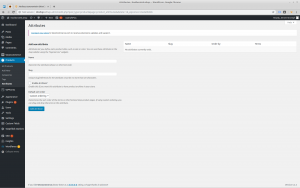Attribuut-taxonomieën (WooCommerce)
WooCommerce kent drie taxonomische systemen: Categorieën (zwaar en veelzijdig), Tags (ken ik niet) en Attributes (licht en eenvoudig, Kenmerken in het Nederlands). Dit artikel gaat over dit laatste systeem.
Attributes komen in twee smaken:
- Predefined Attributes
- Custom Attributes.
Dit hoofdstuk gaat voornamelijk over deze eerste variant.
Database-tabellen
wp_woocommerce_attribute_taxonomies
Tabel wp_woocommerce_attribute_taxonomies Lijkt niets te doen. Zie hoodstuk over verwijdering van attribuut-taxonomieën, elders in dit artikel:
SELECT * FROM kbo3.wp_woocommerce_attribute_taxonomies; attribute_id attribute_name attribute_label attribute_type attribute_orderby attribute_public ------------ -------------- ----------------- -------------- ----------------- ---------------- 5 breedte Breedte text name_num 1 6 diepte Diepte text name_num 1 7 lengte Lengte text name_num 1 8 automatische_stop Automatische stop text name 1
wp_terms
Subtaxons verschijnen gewoon in wp_terms. Dat maakt het gemakkelijk om met subtaxons te werken, want het werkt hetzelfde als voor gewone categorieën.
wp_term_taxonomy
Tabel wp_term_taxonomy verbindt taxons met taxonomieën. Hier kun je zien dat WooCommerce 'onder water' losse taxonomieën defineert voor alle attributen. Je herkent ze aan de prefix pa_. Merk op dat parent=0: Er wordt niet gebruik gemaakt van hierarchie! Ook niet zo vreemd, omdat je bij attributen max. twee lagen hebt. Voorbeeld:
SELECT * FROM kbo3.wp_term_taxonomy where taxonomy like "pa_%"; term_taxonomy_id term_id taxonomy description parent count ---------------- ------- ---------- ------------- ------ ----- 110 110 pa_breedte Breedte-taxon 0 0
wp_term_relationships
Tabel wp_term_relationships verbindt taxons met WordPress-objecten.
wp_termmeta
Tabel wp_termmeta lijkt metadata te bevatten: Als je nog iets extra's kwijt wilt over een taxon, kun je dat hier doen. WooCommerce maakt hier bv. voor product_cat-taxonomieën aan, om de count per hoofdtaxon in op te slaan.
Het lijkt vooralsnog niet gebruikt te worden voor attribuut-taxonomieën.
Database-velden
In het algemeen zijn veldnamen binnen een WordPress-instantie niet consistent. Dat kun je zien aan het ER-diagram elders in dit artikel:
- In tabel wp_users heet de pk ID
- In tabel wp_usermeta heet dit veld user_id
- In tabel wp_posts heet dit veld post_author.
Desalniettemin: Rondom taxonomieën lijken veldnamen consistent te zijn. Anders had dit hoofdstuk weinig zin.
term_id
term_id is de pk voor een taxon of term.
term_taxonomy_id
term_taxonomy_idis de pk van de tussentabelwp_term_taxonomy, die ervoor zorgt dat je een many-to-many-relatie hebt tussentermsenterm_relationships- Zo'n veel-veel-relatie ben ik tot op heden nog niet tegengekomen. Vandaar dat deze twee velden steeds dezelfde waardes lijken te hebben: Er zijn dan evenveel records in beide tabellen
- Overigens: Ik heb geen idee waarom je zo'n veel-veel-relatie wilt hebben, maar daar gaat het nu niet om.
UI-Velden
Dit zijn de velden die ik zoal in de user interface tegenkom. Namen zijn inconsistent en niet-intuïtief
Name - attribute_name
Shown on the front-end
Slug - attribute_label
Max. 28 karakters.
attribute_type
Het soort control dat gebruikt wordt als interface??? Bv.:
select- Beperkt aantal keuzes, zoals een lookup-tabel of voor Boolese waardentext- Tekstveld, lijkt me.
Enable Archives
Dus dat je een 'taxon-pagina' hebt. Altijd doen. Voor Attributes-taxonomieën kun je helaas geen afbeelding of tekst toevoegen (itt. gewone Categorieën) [1]
Custom ordering - attribute_orderby
Niet zo spannend:
menu_ordername- etc.
attribute_public
Taxonomieën worden binnen een WordPress-site veelvuldig gebruikt voor interne aangelegenheden. Bv. om vertalingen bij te houden. Vandaar dat je er voor kunt kiezen om attribuut-taxonomieën verborgen te houden voor gebruikers.
Taxonomie toevoegen
Met taxonomie bedoel ik hier hetzelfde als hoofdtaxon .
Toevoegen van een hoofdtaxon/taxonomie, wil niet lukken met bv. wp_insert_term. Aangezien Attributes een speciaal geval is van een categorie, zou je verwachten dat dit werkt. Maar dat doet het niet. Gelukkig kun je dit op een meer low-level fixen mbv. $wpdb. Daar gebruik ik deze functies voor. Deze staat in één van m'n libraries (niet in functions.php). Geïnspireerd op [2]:
function dvb_add_attribute_taxonomy($attribute)
{
# Add a WooCommerce Attribute-taxonomy
#######################################################################################################
#
# * Somehow, the usual function register_taxonomy doesn't work for WooCommerce Attributes, hence the
# lower-level approach in this function
# * Based on the example https://wordpress.stackexchange.com/questions/244335/creating-custom-woocommerce-attribute-taxonomies-from-a-plugin
# * Jeroen Strompf, De Vliegende Brigade - April 2019
# * To be included in functions.php where appropriate
#######################################################################################################
# Get acces to $wpdb class
#######################################################################################################
#
global $wpdb;
#######################################################################################################
# Verify input
#######################################################################################################
#
if (empty($attribute['attribute_type'])) { $attribute['attribute_type'] = 'text';}
if (empty($attribute['attribute_orderby'])) { $attribute['attribute_orderby'] = 'menu_order';}
if (empty($attribute['attribute_public'])) { $attribute['attribute_public'] = 0;}
if (empty( $attribute['attribute_name'] ) || empty( $attribute['attribute_label'] ) )
{
return new WP_Error( 'error', __( 'Attribute name and/and slug is missing.', 'woocommerce' ) );
}
elseif ( ( $valid_attribute_name = dvb_check_attribute_name( $attribute['attribute_name'] ) ) && is_wp_error( $valid_attribute_name ) )
{
return $valid_attribute_name;
}
elseif ( taxonomy_exists( wc_attribute_taxonomy_name( $attribute['attribute_name'] ) ) )
{
return new WP_Error( 'error', sprintf( __( 'Slug "%s" already in use', 'woocommerce' ), sanitize_title( $attribute['attribute_name'] ) ) );
}
#######################################################################################################
# Insert into WordPress
#######################################################################################################
#
$wpdb->insert( $wpdb->prefix . 'woocommerce_attribute_taxonomies', $attribute );
do_action( 'woocommerce_attribute_added', $wpdb->insert_id, $attribute );
flush_rewrite_rules();
delete_transient( 'wc_attribute_taxonomies' );
return true;
};
function dvb_check_attribute_name( $attribute_name )
{
# Check if a given attribute name is valid
#######################################################################################################
#
# * Based on the example https://wordpress.stackexchange.com/questions/244335/creating-custom-woocommerce-attribute-taxonomies-from-a-plugin
# * Jeroen Strompf, De Vliegende Brigade - April 2019
# * To be included in functions.php where appropriate
if ( strlen( $attribute_name ) >= 28 )
{
return new WP_Error( 'error', sprintf( __( 'Slug "%s" is longer than 28 characters)', 'woocommerce' ), sanitize_title( $attribute_name ) ) );
}
elseif ( wc_check_if_attribute_name_is_reserved( $attribute_name ) )
{
return new WP_Error( 'error', sprintf( __( 'Slug "%s" is not allowed because it is a reserved term.', 'woocommerce' ), sanitize_title( $attribute_name ) ) );
}
return true;
};
Voorbeeld van een aanroep:
<?php
###############################################################
# Call require_once
###############################################################
#
# Functions "dvb_add_attribute_taxonomy" and
# "dvb_check_attribute_name" have been included in functions.php.
# They become available through this "require_once" command
#
require_once("/home/strompf/www/example.com/wp-load.php");
###############################################################
# Define new attribute-taxonomy
###############################################################
#
$attribute_definition = array
(
'attribute_name' => 'attribute-naam (2)',
'attribute_label' => 'attribute-plakker (2)',
'attribute_type' => 'text',
'attribute_orderby' => 'menu_order',
'attribute_public' => false
);
###############################################################
# Create this new attribute-taxonomy
###############################################################
#
dvb_add_attribute_taxonomy($attribute_definition);
Subtaxons toevoegen
- Attribuut-taxonomieën zijn niet-hiërarchisch, en zitten iets anders in elkaar dan product_cat-taxonomieën:
- Subtaxons toevoegen, gaat op dezelfde manier als voor product_cat-taxonomieën, met één verschil: De naam van de taxonomie, is de naam, voorafgegaan door
pa_ - De gebruikelijke API-functie hiervoor:
wp_insert_term
Voorbeeld uit een SQL-script, waarbij pa_breedte de betreffende taxonomie is:
# Create table
##############
#
create table dim1_taxons_tmp
select distinct
dim1,
concat
(
"wp_insert_term('",
replace(dim1, ".", ","),"'",
", 'pa_breedte',",
" array('description' => 'Alle koolborstels met een breedte van ",replace(dim1, ".", ",")," mm',",
" 'parent' => 0, 'slug' => 'breedte-",replace(dim1, "," ,""),"' ));"
) as dim1_php
from root_tmp;
Je weet de 'pa-naam' pas met zekerheid, nadat er subtaxons zijn aangemaakt. Dan vind je 'm terug met zoiets als dit (in SQL):
SELECT distinct taxonomy FROM example_com.wp_term_taxonomy;
Mochten er nog geen taxons zijn toegevoegd:
- Voeg er eentje handmatig toe, om het te testen
- Gebruik je gezond verstand om uit te vogelen wat de naam zou zijn.
Nog één voorbeeld:
<?php
require_once("/var/www/kbo3.dvb/wp-load.php");
wp_insert_term
(
'Met automatische stop' ,
'pa_automatische_stop',
array
(
'description' => 'Alle koolborstels met automatische stop',
'parent' => 0,
'slug' => 'met-automatische-stop'
)
);
wp_insert_term
(
'Zonder automatische stop' ,
'pa_automatische_stop',
array
(
'description' => 'Alle koolborstels zonder automatische stop',
'parent' => 0,
'slug' => 'zonder-automatische-stop'
)
);
Verwijderen
Hoe kun je alle attribuut-taxonomieën compleet verwijderen? Dus inclusief hoofdtaxons, subtaxons, en koppelen met objecten? Voor een beetje serieuse site, is het geen optie om dit handmatig te doen, vandaar. Ik kwam geen kant-en-klare code tegen, dus lekker zelf doen!
De uitdaging is, om de onderdelen in de juiste volgorde te verwijderen, zodat je weet wat-wat is. Als ik bv. terms als laatste verwijder, is er een kans dat ik niet meer weet bij welke taxonomie ze horen. Een impressie:
select * from wp_term_relationships; # Taxons <-> Objecten - Vroeg verwijderen select * from wp_termmeta; # Metadata <-> Taxons - Vroeg verwijderen select * from wp_term_taxonomy; # Taxons <-> Taxonomy - Laat verwijderen select * from wp_terms; # Taxons - Laat verwijderen select * from wp_woocommerce_attribute_taxonomies; # Hoofdtaxons - Als laatste verwijderen
Taxons verwijderen
Dit script verwijdert alle WooCommerce-gerelateerde taxons, inclusief product_cat-taxons:
function dvb_delete_all_woocommerce_taxonomical_data()
{
global $wpdb;
###################################################################################
# Delete all category & attribute taxons
###################################################################################
#
# * This SQL script deletes taxons, not the taxonomies themselves
# * It works at the db-level. It doesn't use any API calls (except for db-access)
# * Is uses a temporary table "taxon_tmp" to hold intermediate results.
# As this is a temporary table, it doesn't need to be explicitly deleted
#
$sql_01 = "drop table if exists taxon_tmp;";
$sql_02 = "create temporary table taxon_tmp select term_id from ".$wpdb->prefix."term_taxonomy where taxonomy like 'product_cat' or taxonomy like 'pa%';";
$sql_03 = "delete ".$wpdb->prefix."termmeta from ".$wpdb->prefix."termmeta where meta_key like 'product_count_product_cat';";
$sql_04 = "delete ".$wpdb->prefix."termmeta from ".$wpdb->prefix."termmeta join taxon_tmp on wp_termmeta.term_id = taxon_tmp.term_id;";
$sql_05 = "delete ".$wpdb->prefix."term_relationships from ".$wpdb->prefix."term_relationships join taxon_tmp on ".$wpdb->prefix."term_relationships.term_taxonomy_id = taxon_tmp.term_id;";
$sql_06 = "delete ".$wpdb->prefix."term_taxonomy from ".$wpdb->prefix."term_taxonomy where taxonomy like 'product_cat';";
$sql_07 = "delete ".$wpdb->prefix."term_taxonomy from ".$wpdb->prefix."term_taxonomy where taxonomy like 'pa_%';";
$sql_08 = "delete ".$wpdb->prefix."terms from ".$wpdb->prefix."terms join taxon_tmp on ".$wpdb->prefix."terms.term_id = taxon_tmp.term_id;";
# Ready to go?
######################################
#
// echo "\nsql_01: ".$sql_01;
// echo "\nsql_02: ".$sql_02;
// echo "\nsql_03: ".$sql_03;
// echo "\nsql_04: ".$sql_04."\n";
try
{
$wpdb->query($sql_01);
$wpdb->query($sql_02);
$wpdb->query($sql_03);
$wpdb->query($sql_04);
$wpdb->query($sql_05);
$wpdb->query($sql_06);
$wpdb->query($sql_07);
$wpdb->query($sql_08);
}
catch(Exception $e){}
}
Attribuut-taxonomieën verwijderen
Om gelijk met iets opmerkelijks te beginnen: Ik kan deze taxonomieën niet handmatig verwijderen binnen de webinterface.
Niet wp_woocommerce_attribute_taxonomies
De tabel wp_woocommerce_attribute_taxonomies lijkt niet te maken te hebben met deze attributen: Als ik de inhoud verwijder, verandert er niets:
wp_options - _transient_wc_attribute_taxonomies
Tjakka: wp_options bevat de definities. Waarde van option_value in bovenstaand voorbeeld:
a:11:{i:0;O:8:"stdClass":6:{s:12:"attribute_id";s:2:"10";s:14:"attribute_name";s:8:"apparaat";s:15:"attribute_label";s:8:"Apparaat";s:14:"attribute_type";s:6:"select";s:17:"attribute_orderby";s:10:"menu_order";s:16:"attribute_public";s:1:"1";}i:1;O:8:"stdClass":6:{s:12:"attribute_id";s:1:"5";s:14:"attribute_name";s:17:"automatische_stop";s:15:"attribute_label";s:17:"Automatische stop";s:14:"attribute_type";s:6:"select";s:17:"attribute_orderby";s:10:"menu_order";s:16:"attribute_public";s:1:"1";}i:2;O:8:"stdClass":6:{s:12:"attribute_id";s:1:"1";s:14:"attribute_name";s:7:"breedte";s:15:"attribute_label";s:7:"Breedte";s:14:"attribute_type";s:4:"text";s:17:"attribute_orderby";s:10:"menu_order";s:16:"attribute_public";s:1:"1";}i:3;O:8:"stdClass":6:{s:12:"attribute_id";s:1:"7";s:14:"attribute_name";s:9:"connector";s:15:"attribute_label";s:9:"Connector";s:14:"attribute_type";s:6:"select";s:17:"attribute_orderby";s:10:"menu_order";s:16:"attribute_public";s:1:"1";}i:4;O:8:"stdClass":6:{s:12:"attribute_id";s:1:"4";s:14:"attribute_name";s:7:"diagram";s:15:"attribute_label";s:7:"Diagram";s:14:"attribute_type";s:4:"text";s:17:"attribute_orderby";s:10:"menu_order";s:16:"attribute_public";s:1:"1";}i:5;O:8:"stdClass":6:{s:12:"attribute_id";s:1:"2";s:14:"attribute_name";s:6:"diepte";s:15:"attribute_label";s:6:"Diepte";s:14:"attribute_type";s:4:"text";s:17:"attribute_orderby";s:10:"menu_order";s:16:"attribute_public";s:1:"1";}i:6;O:8:"stdClass":6:{s:12:"attribute_id";s:1:"3";s:14:"attribute_name";s:6:"lengte";s:15:"attribute_label";s:6:"Lengte";s:14:"attribute_type";s:4:"text";s:17:"attribute_orderby";s:10:"menu_order";s:16:"attribute_public";s:1:"1";}i:7;O:8:"stdClass":6:{s:12:"attribute_id";s:1:"9";s:14:"attribute_name";s:4:"merk";s:15:"attribute_label";s:4:"Merk";s:14:"attribute_type";s:6:"select";s:17:"attribute_orderby";s:10:"menu_order";s:16:"attribute_public";s:1:"1";}i:8;O:8:"stdClass":6:{s:12:"attribute_id";s:2:"11";s:14:"attribute_name";s:21:"originele koolborstel";s:15:"attribute_label";s:21:"Originele Koolborstel";s:14:"attribute_type";s:6:"select";s:17:"attribute_orderby";s:10:"menu_order";s:16:"attribute_public";s:1:"1";}i:9;O:8:"stdClass":6:{s:12:"attribute_id";s:1:"6";s:14:"attribute_name";s:11:"stroomdraad";s:15:"attribute_label";s:11:"Stroomdraad";s:14:"attribute_type";s:6:"select";s:17:"attribute_orderby";s:10:"menu_order";s:16:"attribute_public";s:1:"1";}i:10;O:8:"stdClass":6:{s:12:"attribute_id";s:1:"8";s:14:"attribute_name";s:4:"veer";s:15:"attribute_label";s:4:"Veer";s:14:"attribute_type";s:6:"select";s:17:"attribute_orderby";s:10:"menu_order";s:16:"attribute_public";s:1:"1";}}
In code, toegevoegd aan de code eerder in dit hoofdstuk:
###################################################################################
# Delete attribute-taxonomie-definities
###################################################################################
#
$sql_01 = "delete from ".$wpdb->prefix."wp_options where option_name like '_transient_wc_attribute_taxonomies';";
try
{
$wpdb->query($sql_01);
}
catch(Exception $e){}
